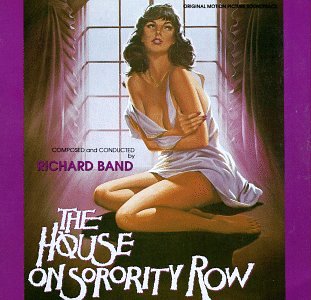My Favorite Scores: The House on Sorority Row (Richard Band)
I can't say it enough, kids: I love film music. The sounds, the melodies, the emotions it arouses. I've had an interest in film music for roughly two decades and, in that time, I've come across a number of scores that I've no qualms about calling my favorites.
Ah, slasher movies. As long as there were teenagers with disposable income in the 1980s, you were sure to find them everywhere: moviehouses, drive-ins, video stores and pay cable. All these years later, it must be said that some were better than others. Sometimes, though, you can put an interesting twist on the same old story.
All the girls of Pi Theta wanted was one last party after graduation. Unfortunately, their housemother wants to shut the sorority house down like she does every year on June 19th. Getting her back with a prank proves to be less than a smart move, as someone offs the girls one by one. It sounds like a typical slasher movie...and it is, in many ways. However, writer-director Mark Rosman proves that his short-lived association with Brian De Palma was not in vain; some stylish touches lift this above the norm.
Given the film's $400,000 budget, it's quite a surprise that Richard Band was able to record music with an orchestra, but thankfully, that proved to be the case. Band's score may well be his best.
The "Main Title" music plays over shots of the girls packing their bags and preparing to depart the sorority house. One would almost expect something a bit more aggressive to play out, but Band treats the scene to a lush sort-of waltz on woodwinds, buoyed by a six-note melody that passes between strings and oboe. The bridge of the cue is also worth mentioning (at 1:19); a surging melody that is as romantic as it is urgent. Only at the track's end, with a sustained note on strings, does the music tip its hand as to the film's genre.
The film does provide a sideways nod to De Palma in its appropriation of Sisters (not to spoil too much, but mad doctor and harmless woman thought to be behind the crimes), as heard in "Slater's Memories" with the earlier score's creepy two-note plucked strings.
This cue also features the score's other main melody, a lullaby on solo voice that is reminiscent of The Amityville Horror, and it's just as evocative. ("Music Box" plays throughout the film, voice and celeste recreating the titular item perfectly.) "Kathy in Attic" continues the mood as Kathy investigates, icy strings and the Sisters motif augmented by bass strings and hints of the music box motif. (A searching motif on strings introduced at 0:50 gets a driving rendition in "Kathy in Horror".)
Still, this is a horror movie and Band does provide a number of cues for the unfortunate ends met by the characters. "Swinging Light Kill" features a creepy scraping noise (perhaps to echo the basement setting) amongst its rumbling orchestral effects, leading to a typhoon of strings and dissonance. (and despite the title, the killer's weapon of choice is a cane). "Jeannie's Flight" throws swirling strings, chattering xylophone and pounding horns at us, effectively conveying someone running for their life.
"Hallucination and Escape" is an entirely odd animal, as our final girl finds herself disoriented (again, spoilers). The cue starts with a twisted electronic version of the music box, leading to a deliberate rendition of the main theme. Voices, strings and low-end piano follow as the hallucinations begin. The music box theme tries to muscle its way through the haze, but the orchestral effects are too overwhelming. Low-end piano, frantic horns and chopping strings abound as she attempts a getaway.
"Kathy in Horror" puts us through the wringer as strings, celeste, horns and voice collide. "Last Hallucination" lulls us into a false sense of safety as the music box motif plays out while Kathy awaits the killer. A brilliant bit of misdirection is cued by rising strings as the killer strikes. A wind machine effect overlay works beautifully to obscure the orchestra and heighten the unease.
"Retribution" broods under the surface before swirling strings, celeste, the music box motif and horns whirl around as Katy finally fells the killer. However, it just wouldn't be a horror movie if there wasn't one last sting telling us that the killer ain't quite dead.
The "End Credits" picks up the pace a little for the music box theme, giving it a gorgeous full orchestral treatment before returning to the "Main Title" music.
If the opportunity arises for you to pick this up, do not hesitate. This is what horror scoring is all about.
Availability: It was released by Intrada a good two decades ago. I was lucky enough to find a copy around the turn of the century for a decent price and while (at the time of this writing, anyway) there's a copy for $14.99 at Amazon, there's a good 10-15 minutes of music missing from the CD. Though the album in its current form flows very well, I can't help but want more. As I mentioned, this may well be Band's best score.
Intrada MAF7040D (1993)
Track Listing:
1. Main Title (2:45)
2. Slater's Memories (1:38)
3. Swinging Light Kill (2:23)
4. Kathy in Attic (3:15)
5. Music Box (1:37)
6. Jeannie's Flight (3:12)
7. The Cemetary (1:23)
8. Hallucination and Escaoe (5:55)
9. Kathy in Horror (1:48)
10. Last Hallucination (1:39)
11. Retribution (1:47)
12. End Credits (4:08)
These next few tracks are from The Alchemist:
13. Main Title (2:39)
14. Prologue (2:14)
15. Graveyard Encounter (3:25)
16. Lenora Follows Aaron (1:24)
17. Aaron's Curse (2:08)
18. The Alchemist's Room (4:38)
19. The Incantation (2:17)
20. Aaron's Last Fight (6:49)
Labels: My Favorite Scores


0 Comments:
Post a Comment
Subscribe to Post Comments [Atom]
<< Home